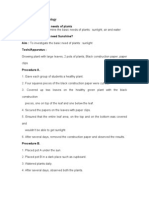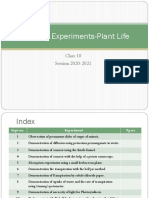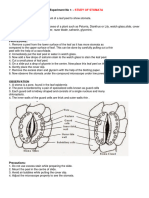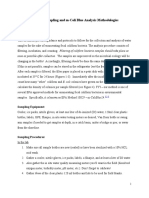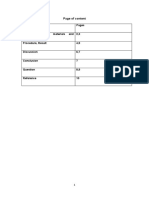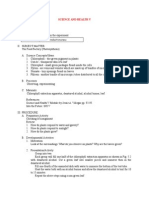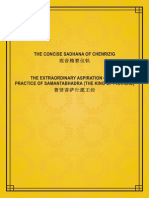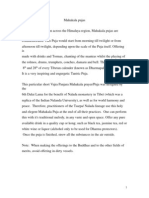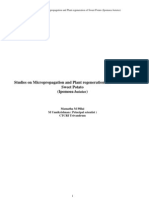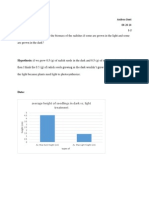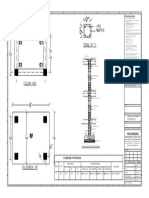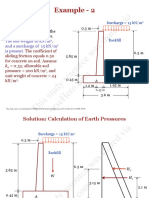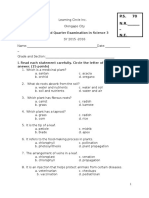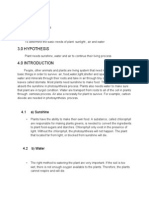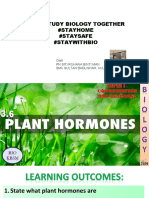Seed Structure and Germination of Seeds
Seed Structure and Germination of Seeds
Uploaded by
Lim Kew ChongCopyright:
Available Formats
Seed Structure and Germination of Seeds
Seed Structure and Germination of Seeds
Uploaded by
Lim Kew ChongOriginal Description:
Original Title
Copyright
Available Formats
Share this document
Did you find this document useful?
Is this content inappropriate?
Copyright:
Available Formats
Seed Structure and Germination of Seeds
Seed Structure and Germination of Seeds
Uploaded by
Lim Kew ChongCopyright:
Available Formats
Name:
Class:
Seed Structure and Germination of Seeds
Investigation 14.1 To examine the structure of a sword bean or broad bean seed - a dicotyledonous, non-endospermic seed
Procedure
1.
Examine the seed that has been soaked in water for about a day. The seed is about 2.5 cm long. It has a thick seed-coat or testa. Note the long, black or brown scar, the hilum, at one edge of the testa. The hilum marks the region where the seed was attached to the fruit. At one end of the hilum is a small opening known as the micropyle where water enters the seed. Locate the micropyle by squeezing the seed gently and note how water oozes out through it. Make fully-labelled drawings of the external features of the seed. Label the following structures: testa, hilum, micropyle, position of the developing root (radicle).
2.
External features of seed Magnification = X
3.
Next remove the testa to reveal the young plant, i.e. the embryo. The embryo consists of two large, creamy cotyledons, a developing shoot (plumule) and a developing root. Since there are two cotyledons the seed is dicotyledonous. Cotyledons are modified leaves. They are thickened with food reserves so that they look quite different from the foliage leaves of the same plant. They store mainly starch and proteins. You can confirm this by carrying out food tests on the cotyledons. Separate the cotyledons. Look for the developing shoot and root. The developing shoot lies between the cotyledons and is protected by them. Use a hand lens to examine the minute leaves of the developing shoot. Make a labelled drawing of what you see.
4.
Seed with testa removed and cotyledons separated
5.
Calculate the magnification of your drawing. Magnifica tion
=X
=X
size of drawing size of specimen
Name:
Class:
Investigation 14.2
To investigate the conditions essential for germination
Procedure
1. Take four specimen tubes and place a wad of cotton wool in each tube. Drop five peas into each tube.
specimen tube alkaline pyrogallol seeds in dry cotton wool seeds in damp cotton wool seeds in damp cotton wool
tube placed in refrigerator
seeds in damp cotton wool
Tube J
Tube 2
Tube 3
Tube 4
Fig. 14.2
Tube 1 Leave it as it is. Therefore the seeds lack moisture. Tube 2 Add sufficient boiled, cooled water to moisten the cotton wooL Lower a test tube containing a solution of alkaline pyrogallol into the tube. Stopper the tube. The alkaline pyrogallol will absorb all the oxygen in this tube. Hence the seeds lack oxygen. Tube 3 Add sufficient water to moisten the cotton wool. The seeds here are provided with both water and oxygen.
Place all the three tubes in a warm place (e.g. in the laboratory at room temperature, about 30C).
Tube 4 Moisten the cotton wool with water and place the jar in a cold place, e.g. in the refrigera tor.
2. 3.
Examine the seeds in the four tubes daily. In which tube do the seeds germinate well?
4.
What happens to the seeds in Tube I, Tube 2 and Tube 4?
Tube 1: Tube 2: Tube 4 :
5.
From your investigation, state the three conditions essential for germination.
Name:
Class:
Investigation 14.3
Question from Singapore-Cambridge GCE '0' level Science Practical Examination, November 1985
~~dMat~~
Procedure
Place equal amounts of the hydrogen carbonate indicator provided into each of the four test tubes standing in the rack or other holder. Label the test tubes A to D. Into test tube A place five dried peas and into test tube B place five germinating peas. Now proceed as follows: (a) Use the straw provided to blow air through the indicator in test tube C. (i) What colour change do you see?
(ii)
Why does the indicator change colour?
(b)
Shake test tubes A and B from time to time and notice any colour changes.
(i)
Which test tube changes colour first?
What colour change do you see?
(ii)
By comparing the colour change with that in part (a), what gas is being produced by the peas?
(iii)
Which process, taking place in the peas, causes the change in colour of the indicator solution?
(iv)
Explain fully why the indicator solution changes colour in one test tube (A or B) and not in the other test tube.
(v)
Why is test tube D included in this experiment?
[C]
You might also like
- XII - Biology Practicle Book PDFDocument45 pagesXII - Biology Practicle Book PDFaniket mishra76% (45)
- STD 12 Biology - Practical Record WorkDocument33 pagesSTD 12 Biology - Practical Record WorkGopika Ramesh100% (3)
- Lu May Kön Chok Sum Gyi Ngo Wo Nyi: Prayer To Dudjom LingpaDocument11 pagesLu May Kön Chok Sum Gyi Ngo Wo Nyi: Prayer To Dudjom LingpaLim Kew Chong100% (1)
- BUILDING TECHNOLOGY 1 - ConcreteDocument60 pagesBUILDING TECHNOLOGY 1 - ConcreteBryan Silloren PiteroNo ratings yet
- Lab Concrete Mix Design C15-C40Document19 pagesLab Concrete Mix Design C15-C40Soundar Pachiappan100% (1)
- Grade 10 Biology PracticalDocument8 pagesGrade 10 Biology Practicalgames23412341No ratings yet
- Skoolbeep File1725628575610 1725628676759Document5 pagesSkoolbeep File1725628575610 1725628676759jlohith195No ratings yet
- Practical Report BiologyDocument12 pagesPractical Report BiologyHaneza NeizaNo ratings yet
- Biology - Practcals-Experiment 1 To 4 PDFDocument8 pagesBiology - Practcals-Experiment 1 To 4 PDFshrey40909No ratings yet
- 10 Bio PracticalDocument6 pages10 Bio Practicalamlanjyotihazarika930% (1)
- Investigation To Show Germinating Seeds Respire and Give Off Carbon DioxideDocument2 pagesInvestigation To Show Germinating Seeds Respire and Give Off Carbon DioxideDeepti VimalNo ratings yet
- Bio Practical Notes XiiDocument10 pagesBio Practical Notes XiimrinalinimalavigaNo ratings yet
- BIO PRACTICAL 10 Class CBSE IndiaDocument12 pagesBIO PRACTICAL 10 Class CBSE Indiaroshni.ahmadNo ratings yet
- Practical Experiments-Plant Life-Class 10 - 1975751724Document28 pagesPractical Experiments-Plant Life-Class 10 - 1975751724Anubhab DasNo ratings yet
- 10 PractcalsDocument28 pages10 Practcals1987kanchanrathoreNo ratings yet
- Science X Practical RecordDocument35 pagesScience X Practical RecordSAMIKSHANo ratings yet
- Class Xi Biology Practical Record Writing 2022-23 - Part 2Document22 pagesClass Xi Biology Practical Record Writing 2022-23 - Part 2Om SolankiNo ratings yet
- Biology VacationDocument20 pagesBiology Vacationhappytimelove586No ratings yet
- Soil Antibiotic ProducerDocument3 pagesSoil Antibiotic ProducerAshen Nirodya0% (1)
- Experiment Procedure Summary - 0Document35 pagesExperiment Procedure Summary - 0Craig Ó BrádaighNo ratings yet
- Preparing A Temporary Mount of A Leaf Peel To Show StomataDocument8 pagesPreparing A Temporary Mount of A Leaf Peel To Show Stomatasaby62911No ratings yet
- Combined Science Notes: Germination: Germination Is The Process Whereby A Seed Becomes A SeedlingDocument4 pagesCombined Science Notes: Germination: Germination Is The Process Whereby A Seed Becomes A SeedlingJessyNo ratings yet
- 7: Isolation of An Antibiotic Producer From Soil: ObjectivesDocument2 pages7: Isolation of An Antibiotic Producer From Soil: ObjectivesLenin Fernandez ArellanoNo ratings yet
- Biology Practical Record Work - Class X (4) 1Document7 pagesBiology Practical Record Work - Class X (4) 1lakshmimaha50061No ratings yet
- Lab Manual Grade 10Document4 pagesLab Manual Grade 10chrisbinoj43757No ratings yet
- practicals bioDocument6 pagespracticals biosonalsharma06pNo ratings yet
- Plant Tissue Culture ProtocolDocument7 pagesPlant Tissue Culture ProtocolMa-anJaneDiamosNo ratings yet
- Biology Manual - STD XDocument23 pagesBiology Manual - STD Xryannemo2008No ratings yet
- Group 2 Sci Germination ExperimentDocument4 pagesGroup 2 Sci Germination ExperimentLance Dy ChuaNo ratings yet
- Biology Practical (1) SSCDocument24 pagesBiology Practical (1) SSCtasfiamrNo ratings yet
- Lab Exercise 5: Pure Culture Techniques: ObjectivesDocument5 pagesLab Exercise 5: Pure Culture Techniques: ObjectivesAnna MaeNo ratings yet
- Class 10 Biology RecordDocument9 pagesClass 10 Biology Recordchetan141mNo ratings yet
- Biology CBSE Practicals Class 10thDocument6 pagesBiology CBSE Practicals Class 10thstudioschilldudes90% (10)
- Coliform Bacteria Sampling and M-ColiBlue Analysis Methodologies-2Document10 pagesColiform Bacteria Sampling and M-ColiBlue Analysis Methodologies-2SamraNo ratings yet
- Bio Lab ManualDocument42 pagesBio Lab ManualabhiiiiwwwNo ratings yet
- AP Lab 4 Diffusion and OsmosisDocument4 pagesAP Lab 4 Diffusion and Osmosissharon chaNo ratings yet
- Biology Manual (6)Document40 pagesBiology Manual (6)aruljoshua2007No ratings yet
- Bio Record ManualDocument14 pagesBio Record Manualmanideep.as.24No ratings yet
- Lab Report 3 (Agr122)Document9 pagesLab Report 3 (Agr122)NURUL HANIM MUHAMAT NOHNo ratings yet
- Class 10 Practical NotesDocument4 pagesClass 10 Practical NotesJanvi PatelNo ratings yet
- Record Work Grade 10Document13 pagesRecord Work Grade 10ibafakih27No ratings yet
- 12ths Biology PracticalsDocument8 pages12ths Biology Practicalsalinrenit123No ratings yet
- bio record experimentsDocument11 pagesbio record experimentsbaladitya0908No ratings yet
- Module 2 - Unit 1 - Lesson 1&2Document40 pagesModule 2 - Unit 1 - Lesson 1&2Angel AlvarezNo ratings yet
- Seed GerminationDocument6 pagesSeed GerminationAdrian GonzalesNo ratings yet
- Chapter 15 (Philoid-In)Document9 pagesChapter 15 (Philoid-In)Shrey BhardwajNo ratings yet
- 10 Bio PracticalsDocument8 pages10 Bio Practicalsaditi2009.soniNo ratings yet
- Screenshot 2021-05-03 at 9.21.51 AMDocument5 pagesScreenshot 2021-05-03 at 9.21.51 AMSaritha NemmaniNo ratings yet
- 02092023095315practicals For Grade - 9 Biology-Part - A 1Document18 pages02092023095315practicals For Grade - 9 Biology-Part - A 1atharvNo ratings yet
- 10th PRACTICALSDocument145 pages10th PRACTICALSsara.m903721No ratings yet
- Kerja Kursus Biologi 1Document10 pagesKerja Kursus Biologi 1Teo Hui pingNo ratings yet
- Master Bio Exp Form 4Document15 pagesMaster Bio Exp Form 4Myramel Klaris100% (3)
- Values: Cooperation, Industriousness: Science and Health VDocument2 pagesValues: Cooperation, Industriousness: Science and Health VRichardDumlaoNo ratings yet
- CORE EXPERIMENTSDocument9 pagesCORE EXPERIMENTSniteshyadav5392No ratings yet
- Experiment 1Document14 pagesExperiment 1dhairyachaudhary24No ratings yet
- Practical Notes LatestDocument10 pagesPractical Notes Latestsiva prakasamNo ratings yet
- Photosynthesis and Transpiration - Copy - 031804Document13 pagesPhotosynthesis and Transpiration - Copy - 031804chibamboallanNo ratings yet
- Biology Experiments 3 To 10Document19 pagesBiology Experiments 3 To 10deeveshagarwalNo ratings yet
- CBSE Class 10 Science Lab Manual - Dicot SeedDocument5 pagesCBSE Class 10 Science Lab Manual - Dicot Seedkavitasharmanews185No ratings yet
- Azzahra Irwita Putri - f1c423010Document2 pagesAzzahra Irwita Putri - f1c423010Azzahra Irwita PutriNo ratings yet
- S5 - Practical 1 and 2Document4 pagesS5 - Practical 1 and 2KhushiNo ratings yet
- Laboratory Manual Of Horticulture - With Illustrations Of Methods, Equipment, And ApparatusFrom EverandLaboratory Manual Of Horticulture - With Illustrations Of Methods, Equipment, And ApparatusNo ratings yet
- Learner Guide- Marketing on Xiao Hong ShuDocument80 pagesLearner Guide- Marketing on Xiao Hong ShuLim Kew ChongNo ratings yet
- Free Body Diagram AnswersDocument4 pagesFree Body Diagram AnswersLim Kew ChongNo ratings yet
- 4e3 A Maths Prelim Exam Paper 1Document3 pages4e3 A Maths Prelim Exam Paper 1ahmedzaki1234No ratings yet
- Mani Sadhana 6 DecDocument121 pagesMani Sadhana 6 DecLim Kew Chong100% (4)
- Chemistry Matters Workbook Chapter 2 Experimental Chemistry AnswersDocument2 pagesChemistry Matters Workbook Chapter 2 Experimental Chemistry AnswersLim Kew Chong83% (6)
- Atisha Light Offering PrayerDocument3 pagesAtisha Light Offering PrayernyomchenNo ratings yet
- New Doc 18Document1 pageNew Doc 18Lim Kew ChongNo ratings yet
- The Lama PrayerDocument1 pageThe Lama PrayerLim Kew ChongNo ratings yet
- Second Semester Examination 2006 Secondary 1 Express: East Spring Secondary SchoolDocument23 pagesSecond Semester Examination 2006 Secondary 1 Express: East Spring Secondary SchoolLim Kew ChongNo ratings yet
- 9-30-12 - Praises To 21 TarasDocument4 pages9-30-12 - Praises To 21 TarasLim Kew Chong100% (1)
- 5090 w11 Ms 21Document7 pages5090 w11 Ms 21Lim Kew ChongNo ratings yet
- I Pray To Buddha AmitabhaDocument1 pageI Pray To Buddha AmitabhaLim Kew ChongNo ratings yet
- Plant ReproductioinDocument8 pagesPlant ReproductioinLim Kew ChongNo ratings yet
- Maharaja Mahakala Translation.Document11 pagesMaharaja Mahakala Translation.Lim Kew Chong50% (2)
- Transport of Materials in Flowering PlantsDocument19 pagesTransport of Materials in Flowering PlantsLim Kew ChongNo ratings yet
- Test of Reasoning Module-6Document4 pagesTest of Reasoning Module-6api-326157720No ratings yet
- 10 Best Tips For Growing CycadsDocument3 pages10 Best Tips For Growing CycadsjohncrusoeNo ratings yet
- Landscaping MechanicsDocument3 pagesLandscaping MechanicsArchimedes Magsayo Casama80% (5)
- Studies On Micropropagation and Plant Regeneration of Sweet Potato (Ipomoea Batatas)Document48 pagesStudies On Micropropagation and Plant Regeneration of Sweet Potato (Ipomoea Batatas)MamathaMPillaiNo ratings yet
- Andrew Dent Radish LabDocument3 pagesAndrew Dent Radish Labapi-252987519No ratings yet
- Effect of Foliar Sprays On Fruit Retention, Quality and Yield of Costata Persimmon TreesDocument14 pagesEffect of Foliar Sprays On Fruit Retention, Quality and Yield of Costata Persimmon TreesKomang SudarmaNo ratings yet
- SRDD1 6 Kanaleta in Detajl Jarka (120510 Koncni) PDFDocument1 pageSRDD1 6 Kanaleta in Detajl Jarka (120510 Koncni) PDFFatima Rekanovic-NuhicNo ratings yet
- All About Bamboo: Information SheetDocument5 pagesAll About Bamboo: Information SheetQuang Minh NguyễnNo ratings yet
- List of Tools & EquipmentDocument3 pagesList of Tools & Equipmentmario100% (5)
- Physiological Disorders in Cole Vegetable CropsDocument33 pagesPhysiological Disorders in Cole Vegetable CropsAkash DesaiNo ratings yet
- Basics of Micro IrrigationDocument16 pagesBasics of Micro IrrigationJames WilliamsNo ratings yet
- Science 1994 Goldberg 605 14Document10 pagesScience 1994 Goldberg 605 14Amalia Nur LatifahNo ratings yet
- Italian Herb Garden PlanDocument2 pagesItalian Herb Garden PlanjhNo ratings yet
- T8@7"C/C 4 T12: Schedule of FootingsDocument1 pageT8@7"C/C 4 T12: Schedule of FootingsMohammed SumerNo ratings yet
- Lecture 18 Design of Retaining Walls Part III PDFDocument8 pagesLecture 18 Design of Retaining Walls Part III PDFMohamed MuayidNo ratings yet
- Fitting Catalog 1Document47 pagesFitting Catalog 1Denny MahendraNo ratings yet
- Bill of MaterialsDocument10 pagesBill of Materialshallel jhon butacNo ratings yet
- 1stability AnalysisDocument93 pages1stability AnalysisSatha IyathuraiNo ratings yet
- Waseem Ahmed: Work Experience SkillsDocument1 pageWaseem Ahmed: Work Experience SkillsWaseem LaghariNo ratings yet
- Water Holding CapacityDocument19 pagesWater Holding Capacityzohaib hassanNo ratings yet
- Performance of Introduced Hybrid Tomato (Solanum Lycopersicum Mill.) Cultivars in The Rift Valley, EthiopiaDocument4 pagesPerformance of Introduced Hybrid Tomato (Solanum Lycopersicum Mill.) Cultivars in The Rift Valley, EthiopiaBright Printing IndustryNo ratings yet
- 2020 Dakota Weed Control GuideDocument152 pages2020 Dakota Weed Control GuideAllanNo ratings yet
- 3 Draft Tech Specs Discussion by DivisionDocument7 pages3 Draft Tech Specs Discussion by DivisionClarence MamucodNo ratings yet
- SCIENCE 3 Exam About Plants and AnimalsDocument6 pagesSCIENCE 3 Exam About Plants and AnimalsDianne Diaz100% (2)
- 1.0 TITLE: 4.1 A) SunshineDocument12 pages1.0 TITLE: 4.1 A) SunshineFakhriyah SaidNo ratings yet
- Chapter 3 Coordination and Response Part 4Document26 pagesChapter 3 Coordination and Response Part 4wienna1987No ratings yet
- GrasshopperDocument10 pagesGrasshopperMaynard PascualNo ratings yet
- MasonryDocument40 pagesMasonryJames Daniel GarciaNo ratings yet







